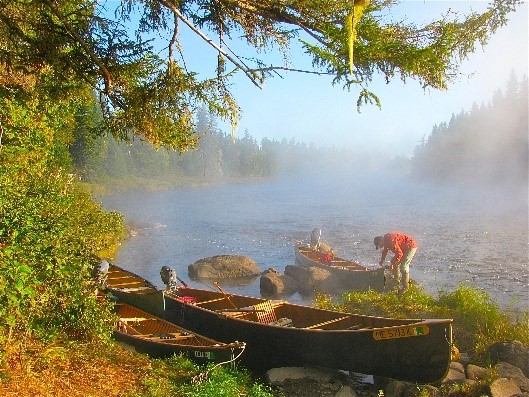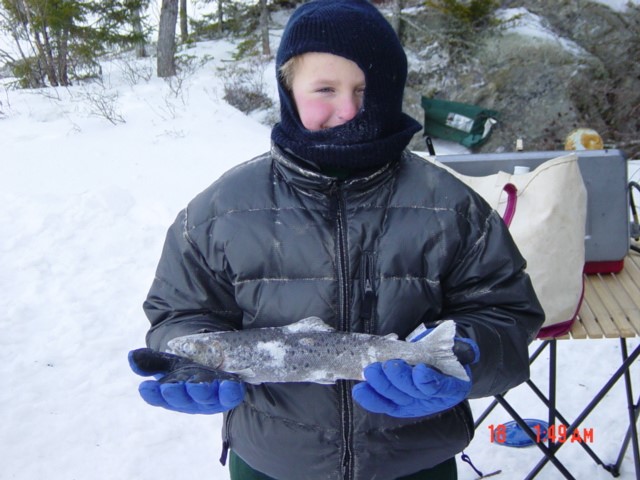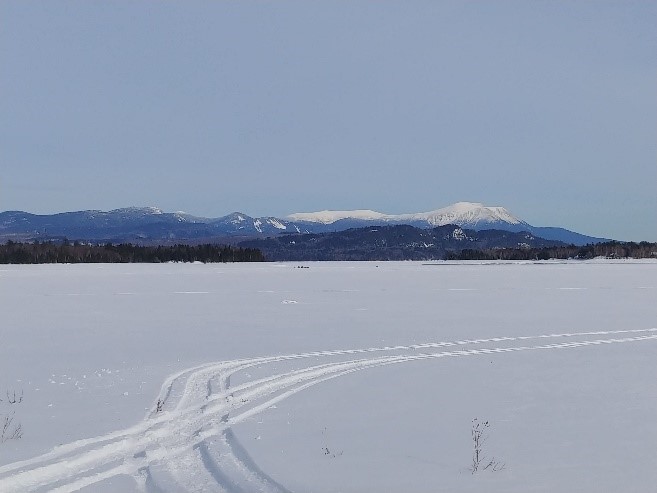April 6, 2018 at 3:10 pm

Foggy morning on the Foxhole. Photo courtesy of Dan Legere.
By MDIFW Fisheries Biologist Tim Obrey When I started work for MDIFW in the mid-1980s, fishing activity was at its peak. Angler use was at an all-time high and I used to cringe the Monday of Memorial Day Weekend seeing the steady stream of traffic heading south all loaded with fish (in my mind anyway) from my favorite trout ponds. Back then, we frequently crafted more restrictive regulations to limit harvest to protect the wild fish resources. It was rare to liberalize regulations. Doing so would have certainly led to overharvest and the depletion of the popular trout and salmon fisheries in the region. But now, things are much different. Overall, fewer people are fishing and those that do practice catch and release at a much higher rate than in the 1980s. This has led to a number of cases where we now have too many fish in some waters. Chesuncook Lake is a glaring example of the pitfalls of too little harvest. Chesuncook Lake has a much–deserved reputation for producing quality-sized salmon. Prior to the 1990s, salmon 2-3 lbs were pretty common along with the occasional bigger fish. The famed September “Foxhole” fishery was outstanding. Most of the mature salmon from the 26,000-acre lake headed upstream into this section of the West Branch. The “best of the best” salmon from the lake created some mighty fine river fishing. I’ve seen several monster salmon exceeding 6 lbs come from this section of the West Branch. Back in the 1980s and 1990s, our winter surveys on Chesuncook Lake showed that there were 3,000-4,000 days of fishing in the winter and anglers were taking home around 1,500 – 2,000 salmon. Chesuncook Lake was one of the prime fishing locations for people living and working in the Millinocket area, just an hour away.

A young ice angler with a Chesuncook salmon.
We implemented a one salmon bag limit and a 16-inch minimum length limit in an effort to maintain the quality of the salmon fishery at Chesuncook Lake in the face of very high use and harvest. Initially, the regulation was working fine and the fishery was holding up well. But then something dramatic occurred. The mills in Maine’s famous mill town were closing. People left the area. Those anglers that remained were getting older and fishing less frequently. The combination of a sharp decline in angler harvest and the very restrictive regulations created a perfect storm for salmon management. The salmon began to stockpile because there was little harvest. This put a burden on the smelt population which is the primary source of food for salmon. We had too many predators and not enough food, which resulted in slower salmon growth. Now, the lake is full of 13-16 inch salmon. These are not bad looking fish and many anglers are happy to catch them, but the behemoths of yesteryear are nowhere to be found. We attempted to alleviate the situation by liberalizing the salmon regulations, but with little success. We estimated total angler use at less than 500 days in 2017 compared to the peak of 4,200 angler days in 1991. The MDIFW has a harvest goal of 2,000 salmon per year until growth recovers. In 2017, the estimated salmon harvest was just 400 fish. Therefore, there is a need to attract more anglers to the lake and encourage them to remove more salmon to reach this goal. This situation is very similar to the problems we had at Moosehead Lake with an over-abundant lake trout population. It took some serious regulation changes at Moosehead Lake to reverse the trend and we are looking at similar strategies for Chesuncook Lake. In 2018, we liberalized the regulations on salmon at Chesuncook to include: No size or bag limit on salmon under 16 inches and a one fish bag limit on salmon greater than 16 inches. We were on the ice this winter and anglers were taking advantage of the new laws, but still, there were not many people making the trek north of the Golden Road. The Natural Resource Education Center at Moosehead, a local educational 501(3)(c) non-profit, has partnered with MDIFW Biologists to organize a salmon fishing derby on the lake this spring to help achieve the lakes management goals and objectives restore a healthy landlocked salmon population. The Chesuncook Lake Salmon Derby will be held on the Saturday and Sunday of Memorial Weekend. A cash prize will be given to the angler that brings in the largest salmon of the derby. Also, anglers will be given one raffle ticket for each salmon under 16 inches that they bring to the weigh station. Another cash prize will be drawn randomly from these raffle tickets. So, make your plans to head to Chesuncook Lake this spring. Get your smoker ready and prepare for some fast salmon fishing, a terrific view, and maybe win a few bucks while helping to restore one of Maine’s best wild salmon fisheries.

View of Katahdin from Chesuncook Lake